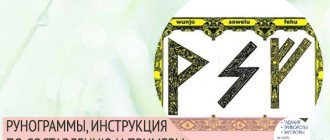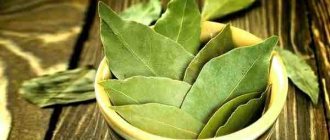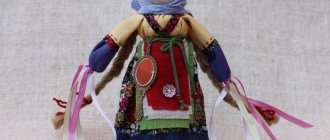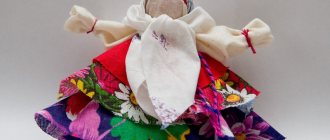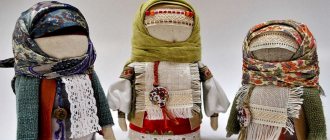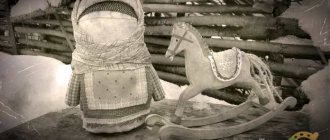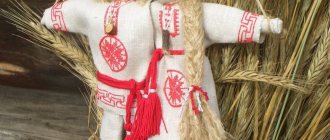Different countries have their own traditions of making toys, but the most unusual is the Slavic handcraft of winding amulets. It turns out not just a toy, but a talisman - a Herbalist doll. A rag jar has a certain sacred meaning; it becomes the protector of the owner, protects children from illnesses, and the family from misfortunes. Craftswomen, along with wishes for well-being, literally put their souls into their brainchild. The traditions of its manufacture have been preserved to this day. But, before describing the master class, let’s go through the pages of history: where did the tradition of making motanki come from, and find out the meaning of the herbalist.
Amulet doll Herbalist, history of origin
The Herbalist doll is a rag amulet, twisted only with natural threads, decorated with a scarf and apron. They are filled not only with the fabric component, but also with threads or cotton wool, dried herbs, and dried flowers. It is customary to place a bean inside the body to protect the child and a coin for wealth. Craftswomen these days combine stuffing: cotton wool and herbs. They flavor their product with a few drops of aromatic oils, and even sell the product in handmade stores. You can, of course, buy a talisman, but it’s more pleasant to make it yourself.
It is difficult to say when the first doll appeared on the planet. Historians suggest that it was created from mammoth bone and that this toy is about 30 thousand years old. Idol dolls were also made thousands of years ago, but the Russian style of creating rag amulets, as historians suggest, originates in the Trypillian culture (approximately 3000 BC).
What was the motive for making amulets with your own hands? Let us remember what the Herbalist doll is actually used for:
- Firstly, it drives away evil spirits, eradicates envy, sadness, as well as hatred and discord. This creates a welcoming, homely aura in the house.
- Secondly, people in those ancient times got sick very rarely, and not with mental, but only with physical diseases, but they still got sick.
The knowledge of herbal medicine inspired our grandmothers to create amulets to guard the family hearth, which also bring health.
The meaning of the Herbalist doll
The main purpose of the Eggpod is to add health to its owner. Housewives filled it with various herbs or just one herb, depending on what they wanted in return: strengthen the immune system, restore strength, relieve stress, fall asleep quickly, eliminate a cold. The herbal pot gave strength, relieved suffering, and healed the body and soul. The herbal aroma wafting through the house was absorbed into every household item, even into the walls, creating a mystical, peaceful atmosphere.
Making your own Herbal Pot
The history of the appearance of the doll goes back many centuries. This amulet has always been in demand by people. The explanation for this lies in filling the amulet with various medicinal herbs.
By releasing beneficial substances, they restored health and strength. Cleaned the air from pathogenic microbes. Plus, they mostly smelled good. And this, as you know, has a calming effect and lifts your spirits.
Many bereginii were kept in places inaccessible to children, but this doll, on the contrary, was made specifically for children. The more the child crushed and squeezed the “toy,” the more phytoncides were released. This means the air became cleaner and the child’s sleep was stronger.
It was also believed that the strong aroma repels evil spirits.
How to make a Herbal Pot is not a question in our time, but there is a traditional way to create a talisman and a description of the process. Although you can always make changes and additions at the request of the master. This applies to fabrics, decorations and much more.
Some people like simple ones, but tightly and firmly wound, while others like them to be more fancy and dress the doll in lace and silk fabrics. By the way, all details of the bereginya must be strictly made of natural fabrics!
Options for pupae
Amulet dolls, herbal capsules, are stuffed with different herbs that have different purposes. Previously, housewives made several small jars for the house and filled them with herbs; each had its own special purpose and place in the home.
- One Herbalist was placed at the bedside of adults or hung near the crib of a small child. She protected their health, not allowing sick people to walk around the house, she protected residents from diseases and evil spirits;
- Another herbal jar was filled with aromatic herbs. Such a doll was placed under the pillows. We used medicinal herbs (mint, lavender, thyme, oregano, motherwort). The amulet calmed, helped in the fight against insomnia, and warded off nightmares;
- The third doll was created for the kitchen. Herbs that cause a good appetite were used for it. First of all, these are: dill, dandelion, rue. This combination of herbs also makes the air cleaner, neutralizes unpleasant odors, and creates home comfort;
- The fourth doll, the herbalist doll, was placed in cellars or lived in a barn. The composition of such a pupa included wormwood, mint, and tansy. It served as a disinfectant that repelled pests.
Guardian of Health
Collected, dried flowers could cure even the most serious diseases, of course, if the plants were used correctly. Aromatherapy still helps many people cope with coughs, allergies, colds, fatigue, nervousness, boost immunity, and so on. Our ancestors, preserving traditions and customs, created stunning magical amulets filled with medicinal herbs.
Home amulet
The grasshopper is a protector; she carefully protects the house from misfortunes. She looks like a housewife who collects medicinal plants. And indeed, in her hands there are two bundles with dry herbs, and she herself is filled with dried flowers. If you wrinkle her skirt or knots, a pleasant smell will spread throughout the house. Once every two years it is recommended to change the filler inside the Egg.
For all occasions
The Herbalist doll is a universal craft, suitable for all occasions: family quarrels, illnesses, lifts the mood, restores the body, plays the role of a stylish accessory, an original toy for a child.
Interesting: Doll Bereginya - the keeper of the hearth
How to make a jug with your own hands: job description
When making reels, you should strictly adhere to certain rules:
- start making in good health, in a good mood and only on weekdays;
- use exclusively natural materials;
- do not use scissors and needles;
- do not chat in vain, but you can talk with the herbs and with your creation or read a prayer;
- do all the work in one sitting;
- in the process, think and say what kind of help you expect from Kubishka, and sincerely believe in her magic.
Reference! In any reel, it is recommended to make only an even number of knots. There are six knots in the Herbalist: the largest is the body, slightly smaller ones are the head, two more identical ones form the chest, and one more in both arms.
To make a doll yourself, prepare the following materials:
- light plain (white, milky, pastel) fabric for the head and arms, size 27 x 27 cm;
- a pair of different colored scraps 15 x 15 cm - for the breasts and for the knapsacks in the hands;
- two canvases for the body - thick white fabric 30 x 30 cm and colorful fabric 35 x 35 cm;
- stripes for the warrior 5 x 10 cm and for the apron 10 x 18 cm;
- flap for scarf 25 x 25, folded into a triangle;
- cord made of hemp or intertwined woolen threads for a belt and red thread for rewinding;
- dried plants and rags for filling.
The herbalist can be filled with grass, leaves or roots of one plant, or you can mix several. If some plants do not combine well when collected, they can still be used in one doll, distributing the herbs among different nodes.
Making a egg cup is easy and very exciting.:
- Lay out the cloth for the head and arms and place a handful of grass or a well-crumpled rag in the shape of a ball in the center.
- Wrap the inner contents so that the straightened ends for the arms are the same length, and tie with red thread in the neck area.
- Fold the fabric on the handles and bandage them, retreating 1 cm from the edge.
- Tie a piece of fabric under the neck with a protective cross, so that a cross is formed in front, and two stripes at the back - one on the neck, the second a couple of centimeters below.
- Form the breasts and arm knots in the same way as the head, the only difference being that you don't need to leave too much loose fabric.
- Raise the doll's arms above his head and temporarily fix them in this position - this will allow you to maintain the correct proportions of the amulet in the future.
- Place the breast spheres close to each other and to the chin area so that the free ends of all three parts point down. Wrap them tightly in this position.
- To create the body, wrap the herb collection in thick white fabric, and place the finished upper part on top of it.
- Lay out the second (colored) piece of material with the right side facing away from you and bend the corners inward, slightly rounding the shape. Then move the structure prepared in the last step to the center. Raise the edges of the colored fabric, at the same time evenly gathering the material so that the frills of the skirt are under the bust, and secure by tying with red thread.
- Fix the apron on the same line, tying it with a twisted rope on top for beauty. At the same stage, release your arms that were previously secured above your head.
- Bend the strip for the warrior in half lengthwise and wrap it around the head so that it falls slightly onto the forehead, and secure it at the back of the neck.
- Tie a scarf on top so that the warrior can slightly peek out from under it.
- We wrap already prepared bags of herbs to each hand and admire the result.
Materials for making a talisman
So, to make a rag doll you will need multi-colored shreds, red threads (necessarily natural!), a needle can be useful for sweeping up the skirt and tightening it, inside which dry plants and seeds are placed. But in our master class it is not used (the skirt is simply tightened with thread).
By the way, did you know that a red woolen thread can heal a person if you tie it on the wrist of a sick person? It’s not for nothing that the reel is tied with red thread. And she should also be faceless, so as not to resemble any other person with her facial features. It is believed that if there is “no face,” then the Herbalist doll will never take away the positive energy of the owner or those around him. Therefore, for this craft, take white natural fabric - linen or cotton.
Quantity and types of materials:
- A piece of white color measuring 20 by 20 cm;
- Two multi-colored pieces (for bustiness) of the same size and two lumps of cotton wool;
- Two pieces of fabric for hands of any color, size 30x30 cm;
- Shreds for making bags of grass that the doll holds in her hands (take approximately 15 by 15 cm squares);
- A piece of white cloth 40 by 40 cm to wrap the grass in;
- Take the same size of colored material and then wrap the white bag;
- Comb, wool or cotton wool for stuffing the head and chest;
- A skein of red thread;
- For a scarf, take a suitable material, cut a triangle of the required size;
- Fabric for an apron, openwork ribbon, belt, headband (fabric for headband) for a scarf;
- Forbs, dried flowers, rhizomes, seeds;
- Decorations for motanka: necklaces, knitted openwork, embroidery (already ready at the time of collecting the Egg Cap).
Collection of herbs
To brew delicious aromatic tea at home, all you need to do is prepare the plants for the winter. But the ability to collect and dry herbs will be useful not only for tea. Plants collected in this way will serve as filler for the protector of your home - the caring Eggbox. In ancient times, healers walked through the meadows in search of interesting things for good reason, because they knew about the wonderful properties of plants.
Be sure to be patient and in a good mood. After collecting certain flowers, leaves and roots, they must be dried in the sun in a well-ventilated area, tied in bunches, and placed in a dark place.
Types of herbs for filling
What dried flowers should I fill the doll with so that it serves as a talisman? According to popular beliefs, evil spirits are well repelled by:
- Nettle;
- St. John's wort;
- Thyme;
- Fern;
- Yarrow;
- Cornflower;
- Hawthorn;
- Geranium;
- Tansy.
You can use both flowers and leaves, stems, roots, and seeds of plants. If they wanted to increase their appetite, they filled it with dill and dandelion; for insomnia and headaches, they tried to stuff the body with thyme, mint, lavender, valerian, and hops. And for the prevention of diseases, chamomile, plantain, St. John's wort, wormwood, elecampane, etc. were used.
Good to know: Rejuvenating herbal medicine - facial massage with herbal bags.
What to fill the Herbalist with?
In order for the doll to truly be a strong amulet, it must be filled with a variety of herbs. Our ancestors were confident that each of them has special properties and can help in various situations. You can choose your own herbs (depending on their magical properties) and fill your bereginya.
Mint helps improve mental performance. But according to legend, the grass received its name in honor of the Roman goddess Menta. She was a symbol of common sense. During exams, students wore mint wreaths. Philosophers especially appreciated this herb.
Lavender has a pleasant aroma and has an antimicrobial effect. The plant relieves headaches and stabilizes blood pressure.
Melissa is used for heart rhythm disturbances, is not a strong sleeping pill, and helps with nervous tremors. Melissa can lower blood pressure, slow breathing and reduce heart rate.
St. John's wort helps with headaches, insomnia and neurasthenia.
Thyme is a strong antiseptic. Thyme has an anti-inflammatory, analgesic effect and is used as a mild sleeping pill.
Oregano has a calming effect and has a beneficial effect on the body during sore throat.
Methods and rules for using a doll
The correctness of tying together the doll of the Herbalist's amulet amulet does not guarantee its magical properties. While working and winding the threads in a spiral, a spell ritual is performed for good luck, happiness, and health. Then the amulet is activated by the craftswoman. Only then is it placed anywhere in the house or given as a gift.
How to charge and activate the amulet
During production, the craftswoman should think about good things, mentally pronounce wishes for health, happiness, and good luck. Remember the future owner of the doll only in a good way, warm up the pieces of fabric between your palms before wrapping them. This way the future amulet will be charged with positive energy and will become spellbound for good things. After Bereginya is ready, you need to have a heart-to-heart talk with her, after activating it, thank her in advance for the grace that she will bring to every member of the household. Then let all family members hold it and put it in the sun to charge it with solar energy.
How to charge and activate the amulet
In order for the amulet to gain power, the craftswoman must talk to the doll. First she must greet her, and then tell her everything that the woman expects from her. You definitely need to thank the doll for appearing in the house. If the amulet is being made for another person, he must be told about this. You need to name the name of the person whom the doll will have to protect and protect.
Only after such a conversation will the talisman be activated. Now it can be placed in the designated place, or it can be given to another person.
Master class on creating a herbalist doll
How to create a herbalist doll with your own hands without using a needle. The basic technique is thread tying and wrapping. All details where you need to use a needle (embroidery on an apron, scarf or belt) are done in advance so that the body is in no case pierced with a needle. For a creative project, take the necessary materials, be positive, and leave other things for later. They say that it is best to take fabric from the favorite clothes of the future owner of the amulet.
Head
First of all, the head of the Herbalist's Egg should appear. It is made from white fabric, stuffed either with herbs, or tow, wool, a skein of woolen thread, cotton wool, whatever. The main thing is that the herbs are present in the skirt and bags in the doll’s hands. We also form the hands from the same fabric using red thread.
Chest and headdress
The large breasts of a folk doll have always symbolized fertility. Therefore, for the craft, take two large squares of colored material, fill them with herbs or a cotton base (so that it is perfectly even - round balls of thread) and tie them with thread, tying 6 knots on each “ball”. The tails will later hide under the body with a skirt. The breasts need to be secured in such a way that it is possible to change the padding, replacing old herbs with new ones.
The head can be decorated in different ways. We suggest first attaching a patch with knots, and then tying a scarf (in the diagram: Figures 4,5).
Skirt
Fill the largest square of white or beige fabric with dry grass and wrap it lightly with thread, forming a ball. Therefore, hide the edges of the flaps from the arms, head and chest inside the body, tighten the thread on the belt more tightly. Cover the torso with the skirt using a large colored scrap, tucking the edges inward so they don't stick out. In this case, the ugly piece of white fabric will be hidden under the skirt.
How to make an apron
You will need a piece of fabric approximately 6 by 9 cm; it is folded along the edges and hemmed. You can leave the fringe at the bottom. It is believed that the energy of all family members is accumulated through the doll's apron. The longer this accessory, the more children there are in the family.
Details
It is the details that make the doll so beautiful and homely. Here you can show your imagination and add elements and decorations according to
Protective cross
Do not forget that before attaching the skirt, you need to lay out a cross from the shoulders to the waist with red thread. Sometimes a cross is formed from threads, ribbons on the face and identifies a connection with the universe.
Pouches
Nodules with herbs are a kind of sachets. They need to be tied to the palms of the hands with a red thread. You can further flavor them by dripping a little oil inside.
Headdress
Previously, girls wore a headband, so it must be tied under a scarf. A small oblong piece to match the scarf will do. Now tie a triangular scarf in a light color.
Decorations
Decorate Kubishka with accessories, as she loves them very much and will be favorable to you and the whole family. You can wear a necklace, attach lace, a ribbon, an embroidered and crocheted apron, and decorate the necklace with a knitted ribbon. The belt will cover unevenness and threads.
Securing parts
Interestingly, traditionally knots were tied only at the navel (belt). Knots were allowed on the arms and chest to attach them more firmly and nowhere else. However, winding is more difficult, since each part can be loosely fixed. It is believed that if you tie a knot, make a wish, wish well to the owner of the amulet.
After all the parts are secured, the DIY herbal pot is ready for use. All threads are cut at a distance of no less and no more than 2-3 mm. After all the manipulations, the bags need to be crushed in your hands, so to speak, to straighten the rag product.
External magical features
The Herbalist doll is similar to other amulets dolls. But it has a number of characteristic features. She prefers bright details - ribbons, beads, embroidery. You can embroider sacred symbols. But this must be done in advance. You cannot use a needle directly while assembling the pupa.
Breast
It must be made round, elastic, and of the same size. But it should look harmonious and proportional to the body. The Herbalist's breast is a symbol of wealth and fertility. The more it is, the more prosperity there will be.
Headdress
The head of the amulet doll symbolizes gentleness, wisdom and prudence. The main difference between the Kubyshka-Travnitsa doll and other dolls is the image of the horns under the warrior. They represent kichiki - an ancient headdress. Previously, it was believed that through him a woman received the power of fertility.
Apron
It also symbolizes fertility - the longer it is, the more children will be born in the family. An apron is a must, as it is a symbol of protection for all family members.
The Herbalist doll's apron symbolizes fertility
It is advisable that the design on it be horizontal and not vertical. This is necessary in order to maintain your wealth. Otherwise, it will “roll” down to the floor.

